Game Mechanics: The Elements of a Fun Party Game
Last week we talked about game mechanics frequently used to create an amazing solo gaming experience and this week we’re going to take things to the other end of the spectrum. That’s right, party games!
When you have a large group of people, it may be frowned upon to break out a solo game and sit in the corner by yourself. You’re much better off opening up a party game that everyone can play. So, let’s look at how to implement the right game mechanics to make a fun party game.
The first thing to note about party games is that they should be easy to learn and teach, with simple mechanics, little setup, and strong interaction.
A great party game can take many forms, so we’ll look at lots of different examples and how they were able to accomplish putting together a fun experience for players by using the right combinations of game mechanics.
Classic Party Games and Twists on these Game Mechanics
When you think of party games, which ones come to mind?
It could be some classic party games like Charades or Pictionary or even Trivial Pursuit.
One thing that these games all have in common is that they are team games. You’ll often, but not always see this is the case, particularly with some of the classic party games.
These games may involve acting, drawing, answering questions, or doing other interactive activities.
Some of the more modern party games have taken these classic party games and thrown in a twist.
For example, Telestrations is a drawing game but rather than players trying to guess what you’ve drawn as a team, you simply draw a picture of something that appears on your card, pass it to the left and have the next person guess what it is. Then they pass it to their left and the next player tries to draw what the last person wrote. This continues until the booklet returns to the original player.
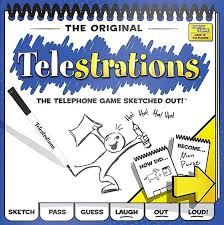
It’s a twist on both Pictionary and the old “broken telephone” game, where one person whispers something into another person’s ear and this gets passed on to the end of the line, with the last person reciting something completely different than the first, often causing explosive laughter.
Wits and Wagers puts a spin on classic trivia games, allowing all players to submit an answer, and adding a betting element. Just a few small changes to this genre created something new and innovative.
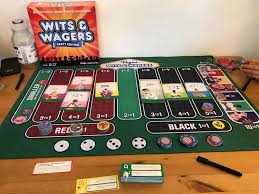
Cranium, on the other hand, combines aspects of Charades, Pictionary, Trivial Pursuit, word games, and other party game favourites all into one box. By including such a great variety all in one game, this ensures that players who aren’t strong in one area can focus instead on their own strengths.
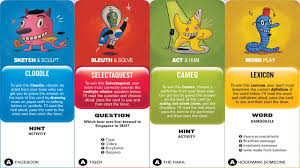
What’s common amongst these games is a simple setup, easy rules, and high interaction. Each also employees a simple system of drawing a card and taking the action described.
Other Party Games and Party Game Mechanics
Some of the newer party games could be dubbed “modern classics.”
This includes games like Apples to Apples, Cards Against Humanity, and Exploding Kittens.
Both Apples to Apples and Cards Against Humanity employ a similar mechanic where players have a hand of cards and choose one to play in reaction to the prompt card chosen by the active player. Then the active player reads all cards allowed and chooses one. The player who submitted the winning card earns a point. Cards Against Humanity is really just a cruder version of Apples to Apples.
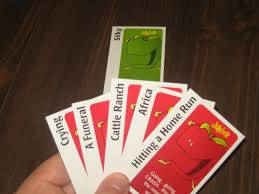
A couple of fun party games that I’ve enjoyed with family over the years are Balderdash and Wise and Otherwise. They are very similar games. In fact, they are made by the same company!
In Balderdash, the active player reads a word you’ve probably never heard of and all other players write down a definition for this word. The active player reads all responses, including the correct one, and everyone votes for their favourite answer (whether they believe it to be true or just hilarious). Points are awarded based on votes and correct responses.
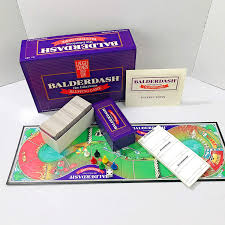
Wise and Otherwise functions exactly the same way, only the active player is reading the first part of a definition or proverb, and all players must complete the expression.
Again, we see a lot of common threads between many of these party games. While some involve drawing, writing, or selecting a card, they are all games that just about anyone can learn and play.
Since party games are targeted more for the casual or mass-market audience, the mechanics are kept simple, which is what you should aim for when creating your own party game.
A few other party games you might want to check out include Wavelength, Green Team Wins, and Just One.
If you playtest a party game with other designers or hardcore gamers, they will likely suggest adding elements and game mechanics that will create more complexity, so be careful with this! Remember who your audience is and gear your game towards them.
Simple game mechanics, like drawing, acting, guessing, betting, and judging often work well in a fun party game.
You want to set up scenarios that create a lot of fun and some contagious laughter. The game should be short, memorable, and enticing for players to want to come back for more.
Scoring is also inconsequential in most party games. Remember: It’s not about winning or losing, it’s about having fun!
What is your favourite party game? What makes it so much fun?
Please leave a comment and let me know.
Next week we’ll be looking at how to make your players feel smart in the games you design.

7 comments
Silas
My favorite party game is codenames because its fast, unless you get a group that thinks to much, and if your new its not like your going against expert players because your on a team versus another team. Also it is easy to learn.
Joe Slack
Hey, Silas! Yes, Codenames is another great one. Easy to learn, team-based, and always a lot of fun. More think-y than most party games, but definitely a good one for a big crowd.
This game made me hungry. – Thy Hoang
[…] have a theme for this particular reason, being suitable for all players. In addition to this, party games are designed for social gatherings to facilitate interaction and provide entertainment. They are […]
Jeremy Guida
Hi Joe,
Thanks for this post! I think my favorite party game is Ready, Set, Bet. It maybe pushes the envelope in terms of simplicity compared to some of these, but once playing, I’d say it’s easy and the feel of it is in the genre.
The post had me thinking that many of these games rely on two related features.
1. Players are often involved in every turn.
2. The rules often introduce relationships between players beyond just competing for points. Being on a team is maybe a gentle shift in this direction, but then voting on results, interpreting results (like telestrations) and wagering on answers introduce and gamify players’ relationship to one another.
This makes sense in party games because they often rely on social elements and player creativity for the source of the fun.
It has me thinking that I would also consider many social deduction games (Secret Hitler and One Night Werewolf) to be party games as well as escape rooms generally and the escape rooms in a box as well.
Joe Slack
Hey, Jeremy! Thanks for the comment. Great insights into party games. Many would agree that these social deduction games and some others could also be considered party games.
asdf
That is a great article. I like the way you summed it up: short, memorable and enticing. It’s not about winning or losing, it’s about having fun.
Joe Slack
Thanks so much!